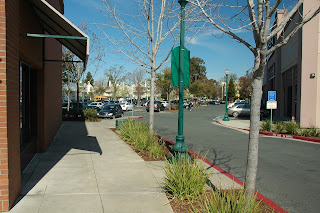 I recently
made a day trip to the East Bay. My
business required only a couple of hours, so I stretched my outing to look at
the downtowns of Pleasant Hill and Pleasanton.
The choice of destinations, which was based a bit on logistical
convenience and a bit on alphabetical proximity, was fortuitous because it
illuminated two approaches to urbanist design.
I recently
made a day trip to the East Bay. My
business required only a couple of hours, so I stretched my outing to look at
the downtowns of Pleasant Hill and Pleasanton.
The choice of destinations, which was based a bit on logistical
convenience and a bit on alphabetical proximity, was fortuitous because it
illuminated two approaches to urbanist design.
In a
conventional sense, Pleasant Hill doesn’t have a real downtown. The town came into full existence during the
era when strip malls and housing tracts were the development norm. But a few years back, a developer tried to
fill the void with Crescent Drive, a faux downtown near the center of the
community.
 The impulse
was reasonable, but the execution missed the mark. In an era when we’re rediscovering knowledge
about how downtowns work, the lessons were ignored in Pleasant Hill.
The impulse
was reasonable, but the execution missed the mark. In an era when we’re rediscovering knowledge
about how downtowns work, the lessons were ignored in Pleasant Hill.
There isn’t
a residential component to add life to the streets. Instead, the land uses closest to Crescent
Drive are mostly parking lots for Crescent Drive shoppers.
Walkability
is limited to the pedestrian routes between the parking lots and the
shops. Outside of Crescent Drive, much
of the existing development is pedestrian unfriendly big boxes and strip malls.
What remains
is attractive but generic architecture, banners describing the area as
“downtown”,
I sympathize
with the problem faced by the developer.
It’s hard to create a downtown decades after the town came into
existence. But an incremental approach
would have been better. (Although I’ll
acknowledge that financing would have been difficult.) Crescent Drive feels like an attempt to be
too much too soon. Which resulted in a
development that is little more than inadequate and quickly aging eye candy.
 Pleasanton
is on the other end of the scale. It’s a
marvelous downtown that clearly dates to the early days of the community. The arch sign, even with the retrofitted neon
tubing, feels authentic. The storefronts
are varied and interesting. And the
perfectly preserved filling station is guaranteed to evoke smiles.
Pleasanton
is on the other end of the scale. It’s a
marvelous downtown that clearly dates to the early days of the community. The arch sign, even with the retrofitted neon
tubing, feels authentic. The storefronts
are varied and interesting. And the
perfectly preserved filling station is guaranteed to evoke smiles. But it seems
that little beyond preservation has been done to make downtown vibrant. It has an oddly linear configuration, only
one street wide and about a half-mile long.
It may be the best location in the Bay Area for a small town parade, but
it’s not convenient for pedestrians to explore, with the only route being up
and down the same street.
But it seems
that little beyond preservation has been done to make downtown vibrant. It has an oddly linear configuration, only
one street wide and about a half-mile long.
It may be the best location in the Bay Area for a small town parade, but
it’s not convenient for pedestrians to explore, with the only route being up
and down the same street.
The linear
downtown reminded me how much I enjoy the North Bay cities like Sonoma, Santa
Rosa, Healdsburg, Napa, and Petaluma that offer multiple routes for a downtown
amble.
There are
charming residential neighborhoods in Pleasanton, but they’re too far from
downtown to be readily convenient on foot.
Nor does there seem to have been any effort to widen or to strengthen
the downtown. Underutilized parcels
exist only a block away, but there was no evidence of an attempt to add
residential to enliven the downtown or commercial to enhance the pedestrian
experience.
 I didn’t
research the municipal planning documents to see if there was a vision that
hadn’t yet reached the ground. But my
observation of downtown showed a place that was resting on the laurels that
came from preservation and hadn’t yet grasped the problem of making the
downtown truly vibrant.
I didn’t
research the municipal planning documents to see if there was a vision that
hadn’t yet reached the ground. But my
observation of downtown showed a place that was resting on the laurels that
came from preservation and hadn’t yet grasped the problem of making the
downtown truly vibrant.
Creating a functional downtown is a challenge
that must be met with both enthusiasm and restraint. Neither Pleasant Hill nor Pleasanton seems to
have found the right balance.
As always,
your questions or comments will be appreciated.
Please comment below or email me.
And thanks for reading. - Dave Alden (davealden53@comcast.net)


No comments:
Post a Comment